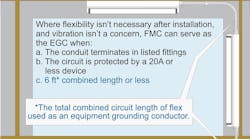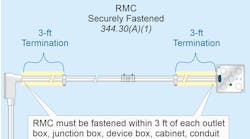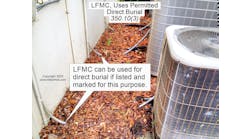All questions and answers are based on the 2011 NEC.
Q. When am I permitted to place two conductors on the same terminal?
A. Terminals for more than one conductor and terminals used for aluminum conductors must be identified for this purpose, either within the equipment instructions or on the terminal itself [110.14(A)].
Split-bolt connectors are commonly listed for only two conductors, although some are listed for three. But it’s common industry practice to terminate as many conductors as possible within a split-bolt connector, although this violates the NEC.
Many devices are listed for more than one conductor per terminal. For example, some circuit breakers rated 30A or less can have two conductors under each lug. Grounding and bonding terminals are also often listed for more than one conductor under the terminal. Each neutral conductor within a panelboard must terminate to an individual terminal [408.41].
Q. When can flexible metallic conduit serve as an equipment grounding conductor?
A. Listed flexible metal conduit (FMC) can serve as an equipment grounding conductor where [250.118(5)]:
a) The raceway terminates in listed fittings.
b) The circuit conductors are protected by an overcurrent device rated 20A or less.
c) The combined length of the flexible conduit in the same ground fault current path doesn’t exceed 6 ft (Figure).
d) If flexibility is required to minimize the transmission of vibration from equipment or to provide flexibility for equipment that requires movement after installation, an equipment grounding conductor of the wire type must be installed with the circuit conductors per 250.102(E), and it must be sized in accordance with 250.122, based on the rating of the circuit overcurrent device.
Informational Note: The equipment grounding conductor is intended to serve as the effective ground fault current path. See Sec. 250.2.
The effective ground fault path is an intentionally constructed low-impedance conductive path designed to carry fault current from the point of a ground fault on a wiring system to the electrical supply source. Its purpose is to quickly remove dangerous voltage from a ground fault by opening the circuit overcurrent device [250.2].
Q. What are the requirements for dedicated space for electrical equipment?
A. Switchboards, panelboards, and motor control centers must have dedicated equipment space as follows [110.26(E)]:
• When located indoors, the footprint space (width and depth of the equipment) extending from the floor to a height of 6 ft above the equipment or to the structural ceiling, whichever is lower, must be dedicated for the electrical installation. No piping, ducts, or other equipment foreign to the electrical installation can be installed in this dedicated footprint space [110.26(E)(1)(a)].
Exception: Suspended ceilings with removable panels can be within the dedicated footprint space [110.26(E)(1)(d)].
Electrical raceways and cables not associated with the dedicated space can be within the dedicated space. These aren’t considered “equipment foreign to the electrical installation.”
• Foreign systems can be located above the dedicated space if protection is installed to prevent damage to the electrical equipment from condensation, leaks, or breaks in the foreign systems[110.26(E)(1)(b)].
• Sprinkler protection piping isn’t permitted in the dedicated space, but the NEC doesn’t prohibit sprinklers from spraying water on electrical equipment [110.26(E)(1)(c)].
• A dropped, suspended, or similar ceiling isn’t considered a structural ceiling [110.26(E)(1)(d)].





